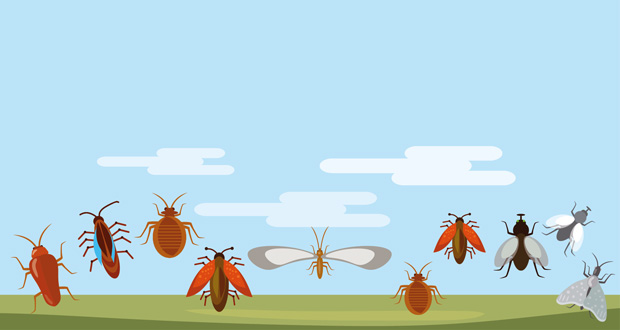BPCA’s Technical Manager, Natalie Bungay, outlines some common pest problems that can be encountered during the summer months
Rising temperatures herald the start of insect season and as spring drifts into summer, insect activity can intensify and cause potential problems for FMs.
Stored Product Insects (SPIs) are the world’s most expensive pest, costing businesses billions in additional costs and loss of product each year. SPIs, like any ‘indoor’ insect, can be an issue and more likely to be present during the summer months.
Blow flies, commonly known as bluebottles – are also a potential issue year-round, but more likely to become a problem over the summer, along with sewage flies, red poultry mites, textile moths and beetles, fruit flies, bed bugs, fleas and furniture beetles.
Tropical ants and cockroaches, may be present at any time of year, while houseflies, garden ants, mosquitoes, wasps and honeybees are usually only active in spring and summer.
As well as insects, birds can sometimes cause issues for businesses, with feral pigeons nesting year-round and gulls more active from April to August when they begin to nest.
Pests such as rats and mice tend to be less active in human environments in spring and summer, as there is a wealth of resources outdoors, mitigating their need to search buildings for warmth and food.
WHAT ARE THE RISKS?
Insects can cause a range of issues from risks to the health of people working on site and contamination of product, to damage to equipment and even structural problems.
RISKS TO HEALTH:
- Wasps – a wasp sting can cause anaphylaxis, an allergic reaction which can be life-threatening if swift action isn’t taken. In late summer, wasp nests can be home to between 3,000 and 8,000 wasps. A wasp that feels threatened can emit a pheromone that acts as a distress call to other wasps and can trigger a defensive stinging frenzy.
- Cockroaches – known vectors of disease, cockroaches carry organisms that cause food poisoning such as salmonella, staphylococcus and streptococcus.
- Flies – a family of two-winged polluters, flies commute from filth to food. Most species feed by vomiting saliva onto food surfaces and sucking up the resulting liquid. This contaminates food product with bacteria from their gut and feet.
- Feral pigeons – diseases can be transmitted from bird droppings and the birds themselves. Feral pigeons can reportedly carry around 110 pathogens, while their droppings, when dry, can become airborne in small particles, which can lead to respiratory complaints. Research suggests up to 49 per cent of feral pigeons could be infected with Chlamydia psittaci. The human infection is called ornithosis and symptoms include chills, fever, sweating, severe weakness, headache, blurred vision, pneumonia and possibly death. Nesting materials can block chimneys, flues and guttering, causing potential issues with carbon monoxide and water overflow. Pigeon droppings are acidic and can corrode metal, stone and brickwork.
- SPIs – as well as contaminating products such as grain, cereal and tobacco, SPIs can also form a webbing which can cause significant damage to machinery and equipment.
- Textile moths and beetles – the larvae of these insects feed on natural fabrics such as wool, silks, cotton, furs, hides and feathers, leaving signs of damage and even holes in clothes, carpets and furnishings.
- Honeybees – a key pollinator, honeybees are vital to our eco system, but can occasionally cause issues if they nest in the wrong place. Honeybees have been known to settle in lofts or wall cavities, where their honey-making activity can cause damage to the building and attract other pest such as wax moths. Wherever possible, honeybees should be removed rather than controlled.
WHEN TO CALL IN THE PROFESSIONALS
The British Pest Control Association is the UK trade association representing organisations with a professional interest in the eradication of public health pests. Pest professionals from BPCA member companies are best placed to advise on proofing measures including hygiene protocols and waste disposal and to assist FMs in ensuring premises are compliant with relevant legislation.
It is important to understand that tackling a pest infestation requires a process that can take several weeks or even longer. It is not enough to treat the pests that are visible. Insects will lay eggs that could hatch within days, weeks or even months and some species, such as cockroaches and bed bugs, are notoriously difficult to treat.
If wild birds such as pigeons or gulls become a problem, it is vital to consult a pest professional for advice as all wild birds, their nests and eggs are protected under the Wildlife and Countryside Act 1981.
An optimum method to support compliance with legislation and help prevent pest infestations is to establish a pest control maintenance cycle – a planned series of regular visits to check for and treat specific pests and recommend actions to prevent infestations.
A pest management professional will provide a comprehensive report with clear points for action between visits, a report on any chemicals used and a strategy for dealing with any pest issues found.
Regular visits from a pest professional can also help in supporting on-site staff to report sightings of pests, which enables swift action to be taken before a potential infestation can escalate.





